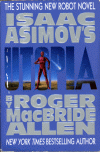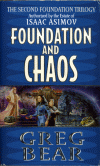Frank Herbert caps off his Dune Trilogy with Children of Dune. Paul “Muad’Dib” Atreides embraced his fate as a blind Fremen by walking into the desert approximately 9 years ago. His sister Alia oversees the religion of Muad’dib, and seems to be enjoying the power that comes with it as the de facto leader of the Empire. Paul’s twin children Leto II and Ghanima are being protected by Stilgar at Sietch Tabr. The main concern, which is well justified, is the fear that the Atreides twins will be assassinated.
To complicate matters, the twins are “pre-born” just as their sister Alia is. I was confused at first because I thought this only to be possible when a Reverend Mother takes the Water of Life while pregnant. After some Google searches, I found that they were pre-born due to the high levels of spice in Chani’s diet. Still, I wonder why not more Fremen are pre-born, since they all ingest spice daily. Herbert answers this question by integrating the “Trial of Possession,” a Fremen ritual which determines if someone has become Abomination. If it finds that someone is taken over by an ancestor’s dominant personality they are put to death. Despite this explanation, this inconstancy still bothers me.
This turned out to be only the beginning of my confusion. I found myself assailed by a multitude of ancient sayings and rituals which made no sense and had little or no explanation. I am sure that much of the philosophy that Herbert was trying to portray simply went over my head. In the beginning I tried to make some sense of these many instances of confusing ramblings, but in the end I decided to just skim over most of them so I could move on to see how the plot progressed.
One of the aspects that Herbert succeeded in explaining was the complex interactions involved in the pre-born. While the Water of Life ritual transfers the knowledge of all previous Reverend Mothers, being pre-born unlocks the genetic memories of all ancestors back through time. Ghanima and Leto II have a unique relationship because they both possess the memories of the same blood line. In a way they are almost the same person, although a different physical sex.
Leto II is the obvious choice as successor to the throne, but he is still only 9 years old. House Corrino is controlled by one of Irulan’s sisters, Wensicia Corrino. She plans to have the twins hunted down by specially trained tigers so that her son Farad’n can become Emperor. While the assassination plot against the twins progresses, Lady Jessica has been sent to Dune to determine if Alia, Ghanima, or Leto II have the signs of becoming Abomination.
The twins have carefully avoided the dangerous spice overdose, which creates a higher risk of becoming Abomination. Unfortunately, Alia overdosed on spice back in Dune Messiah in an attempt to experience prescience as Paul had done. Alia’s struggle with her internal personalities is much more difficult because of this.
Aside from the assassination plot against the twins, and the struggles of the pre-born against becoming Abomination, there is the ecological transformation of Dune which is progressing faster than ever expected. Fremen have become lax in their conservation of water as it is no longer as scarce as it was once before. Greenery is now encroaching on the vast deserts of Dune. In addition to the climate change, the amount of worms spotted has decreased and Spice production has dropped drastically. Everyone except the twins seems ignorant as to the implications of this rapid change. The obvious conclusion is that the spice might eventually cease to be.
After some very weird role playing with Ghanima as Chani and Leto II as Paul, Leto II has a vision of a Golden Path which will hopefully help avert this catastrophe. Everyone seems to underestimate the twins because they appear to be children on the outside. They draw upon their ancestral memories and conclude that there is a plot to assassinate them, and find a way to manipulate Jessica into helping them with their plan. This Golden Path is very clear to the twins, but Herbert hides virtually all of the details of this goal from the reader, which I found very frustrating. Even having read the end of the novel, I’m still not clear as to what exactly this Golden Path is supposed to accomplish.
To complicate matters further, there is a blind man from the desert called The Preacher, which speaks out against the religion of Muad’Dib. He argues that the religion of has become a mockery, something that is just a way to pacify the public. Alia is disturbed by this man because he represents a threat to the absolute power that she enjoys.
The intricacies that seemed so complicated in Dune become mere child’s play compared to those in Children of Dune. It seems that the characters in this novel, aside from the twins, are just as in the dark as the reader. I found myself lost in the multitude of “feints within feints within feints.” This added to my frustration when combined with the unexplained ancient sayings and rituals.
The last quarter of the book went into a direction that nobody could possibly have imagined. It seemed like Herbert kept trying to outdo himself by making Children of Dune exponentially weirder as it progressed. I’m not saying that what happens isn’t plausible, but it just seems out of character with the rest of the series. I don’t think that anyone that read the first book would have thought that the Dune Trilogy would have turned out as it did.
With that said, Children of Dune is obviously the product of intense research and creativity on Frank Herbert’s part. From what I have read and heard over the years, the books that follow the original trilogy become even more incomprehensible. Despite this, I am a completist, so will probably read the rest of the series. I’ve actually already checked out the next book, God Emperor of Dune and read the first 2 sections. I’m not sure if I can wait until I finish the next 3 books before I finish reading the Chaos Theory book on my reading list. Now I need to watch the Sci-Fi Miniseries Children of Dune to see how well it covers the last 2 books.


